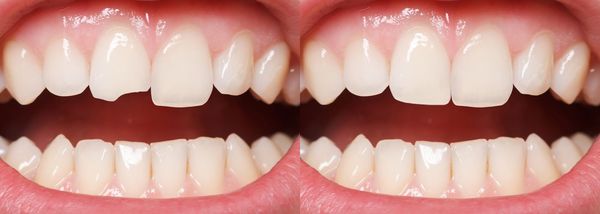Dental bonding is a procedure that employs a tooth-colored composite resin substance to improve your smile. This process is used to repair chips, fill in gaps, or modify the color and contour of a tooth. In comparison to other cosmetic dental procedures like porcelain veneers, dental bonding is totally reversible.
In this article we will discuss in detail about dental bonding and dental bonding before and after.
When is Dental Bonding Required?
Dental bonding is a procedure that may be used to enhance the aesthetics of your smile. The method makes use of a composite resin material that is tooth-colored to:
- Conceal cracks or chips in your teeth
- Make the teeth look longer
- Camouflage tooth discoloration
- Close spaces and gaps between your teeth
- Change your teeth’s shape
Dental bonding is accomplished using the same composite resin material that is used in restorative dentistry to accomplish the following:
- Fill cavities
- Remove any old silver tooth fillings and replace them with a more aesthetically pleasing option
- Guard the exposed tooth roots that have become visible as a result of receding gums
How Common is Dental Bonding?
Dental bonding for cosmetic purposes is quite prevalent. In fact, it is one of the dental operations that is carried out most commonly in the modern day.
Difference Between Dental Bonding and Veneers

Porcelain veneers are thin shells of ceramic that are fabricated to the patient's specific needs and attach to the front surfaces of the teeth. In order to properly install them, your dentist will often need to scrape away part of the enamel from your teeth. Once they have been bonded into place, porcelain veneers cannot be removed. Every ten to twenty years, they will need to be replaced.
On the other hand, when it comes to dental bonding, extensive enamel removal may not be necessary. As a direct consequence of this, bonding is fully reversible. It is anticipated that you will need touch-ups every 3 to 10 years.
Dental Bonding Before and After

What Happens Before Dental Bonding?
The dentist will sit down before the dental bonding procedure to discuss the aesthetic objectives you have for your smile. In addition, they will inspect your teeth and gums, as well as take dental X-rays, in order to determine whether or not you are a good candidate for dental bonding. If you have severe gum disease, tooth decay, or any other major oral health concerns, you will most likely need to address those issues first.
What Happens After Dental Bonding?
After having dental bonding done, it is crucial to maintain good oral hygiene in order to keep your mouth healthy. You should brush your teeth with fluoride toothpaste and a soft toothbrush at least twice per day, and you should floss your teeth once per day. You also need to see your dentist regularly for checkups and cleanings.
Is Dental Bonding Painful?
When you have dental bonding, you won't typically experience any pain since your dentist won't be operating anywhere near the nerve that senses pain in your tooth. Dental bonding often does not even require the use of an anesthetic in the majority of situations. Some patients may have a transient increase in sensitivity to hot and cold temperatures after having dental bonding done. Some of the pain medicines that are available without a prescription may be able to help alleviate some of the pain.
The Advantages of Dental Bonding
When compared to other aesthetic procedures, cosmetic dental bonding has numerous advantages to offer patients. The advantages include:
- The procedure is minimally invasive. In comparison to dental crowns and porcelain veneers that require a tooth alteration, teeth bonding usually does not require enamel removal.
- Dental bonding is cost-effective. It is one of the most economical cosmetic dental procedures today.
- Teeth bonding can deal with a variety of cosmetic imperfections such as discoloration, gaps, cracks, and chips.

